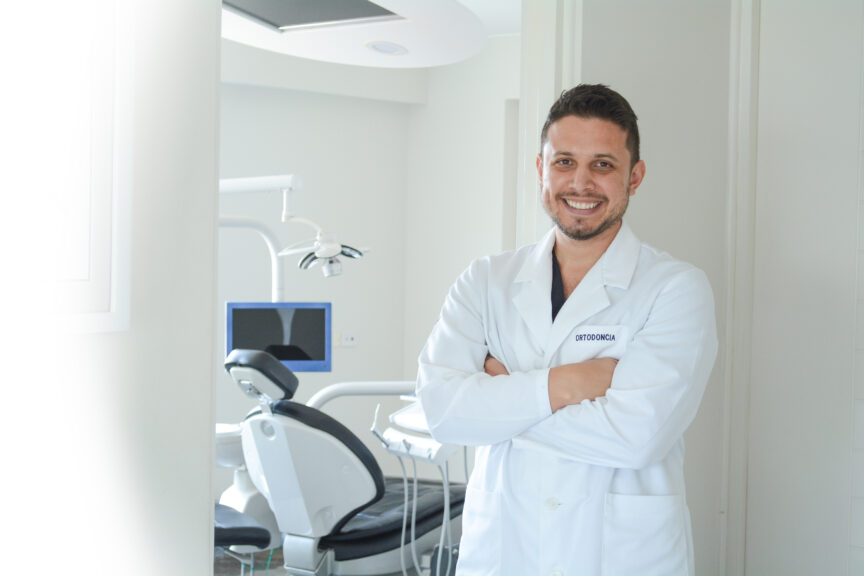How long have you been practicing for? Where did you go to school?
I worked for 4 years as a general dentist / orthodontic resident and 11 years as an orthodontist. I went to Cayetano Heredia (Perú) for both dental school and residency.
You have an amazing clinic! Are you mostly focused on the business of dentistry or just dentistry?
Mostly orthodontics (clinic work and academic). I do a lot of interdisciplinary dentistry. I treat mostly adult patients for orthodontics combined with other specialties. I don’t know a specific reason, but maybe because the clinic is advertised as concerned about esthetics and smiles, so adult patients come over seeking that. My wife is also a good cosmetic dentist, so maybe that too?
How do you manage all of these interdisciplinary cases?
I don’t have a choice! As most patients are adults, I have to do orthodontics with missing teeth, missing molars, gingival recessions, implants, and extruded teeth. So, for treating these kinds of patients, the records are super important for us. Photography allows me to communicate with the other dentists in my clinic. To have all the specialists in one building is a big advantage. We do short meetings for planning or, when we’re busy we send a lot of pictures and voice messages between each other. No secret, just good communication. I once read in a book that said, “The difference between multidisciplinary dentistry and interdisciplinary dentistry is that in multi, multiple specialists treat a patient while in inter, the specialists interact between each other before treating the patient.” This will become a high-quality treatment, and that is what we want for our patients.
Speaking of your photos, how did you get so good and develop this? How did you get into it?
I had my first course in residency, but it was photography for orthodontics – very simple. I wanted more, so I then learned from a guy that teaches aesthetic dentists how to do photography (he was a Brazilian photographer, not a dentist). And then after that, I learned a lot on YouTube, and I kept practicing. Having better pictures helped me a lot to watch details and communicate with other dentists. It is also good for me because it helps me critically evaluate my work.
What’s your camera setup?
Nowadays, I’m shooting with twin flashes and diffusers. Nikon D7100 with a Nikkor 105 mm. Sometimes I use a soft box, but I’m trying not to now because the softbox room is one floor over my office, and walking there with the patient is a waste of time.
Are you teaching any courses in Peru?
I’m an adjunct faculty member at Universidad Científica del Sur, but I only do special topics. I’m also an occasional lecturer at Seton Hill in Pennsylvania, and I am the new editor of Pearls section of the Journal of Clinical Orthodontics (JCO). I have done some publications too, but what I love the most is lecturing for orthodontic and non-orthodontic Congress.
What would you say are the differences/similarities between Peru and other countries like the US?
In Peru, you have to do a lot by yourself. There is no school for assistants. Maximum, I have 1 assistant in another chair, but that’s it. Less delegating for orthodontists compared to the US.
What are some products you’re using?
As for brackets, I don’t have a favorite brand. I think that with clear objectives and a treatment plan you can solve anything with any bracket, as long as you choose the prescription you need. For bonding, I love Reliance products and Transbond (UNITEK) for bonding. Reliance or SS White burs for removing composite and for fixed retainer Orthoflex. American Orthodontics or Rocky Mountain plier are very nice too. I’m using Invisalign for clear aligners. There aren’t many options here in Peru yet.
What are your thoughts on social media?
I’m very active in Facebook groups, especially orthodontic pearls. I like to share cases or pearls there; that’s how I got involved in the JCO. I also use my IG page (@drsergiovalverde) to connect with dentists around the world. This also helps me in recruiting patients, but mostly for sharing with dentists. To complement, we have an Instagram for the clinic (@infinityclinicadental), which is more for patients. In the past, patients used to ask for CVs (which is important), but nowadays, they like to see what their doctor can do for them! They like to see us solving cases, especially the ones similar to what they have in their mouth. So social media can help to build a connection with our patients, which is the beginning of a relationship of trust.

